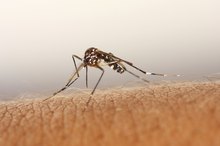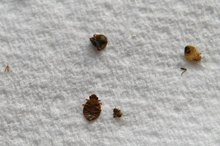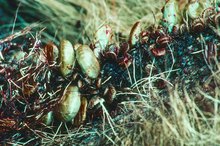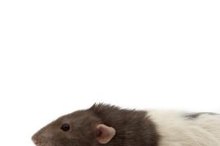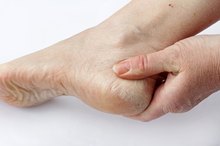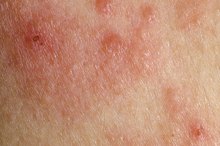What does fact checked mean?
At Healthfully, we strive to deliver objective content that is accurate and up-to-date. Our team periodically reviews articles in order to ensure content quality. The sources cited below consist of evidence from peer-reviewed journals, prominent medical organizations, academic associations, and government data.
The information contained on this site is for informational purposes only, and should not be used as a substitute for the advice of a professional health care provider. Please check with the appropriate physician regarding health questions and concerns. Although we strive to deliver accurate and up-to-date information, no guarantee to that effect is made.
Differences Between Bedbugs & Chiggers
Chiggers and bedbugs are insects with bites that can make life miserable. Although both insects feast on human blood, many key differences between the two pests exist. The most effective way to avoid bedbugs and chiggers is to learn how to identify them so that you can stay out of their way. Unfortunately, it is very difficult to control both types of critters.
Identification
Bedbugs are reddish-brown insects that live indoors. They have an oval shape and grow to the size of an apple seed, according to the Mayo Clinic 1. True to their name, bedbugs infest bed frames, box springs and other nooks and crannies of the bed. Bedbugs are generally found in hotels, homeless shelters and hospitals. Chiggers are a larval stage of the Trombiculidae mite. Such organisms are very small, 1/150th of an inch in diameter, according to the Missouri Department of Conservation. They live outdoors in places with tall weeds, tall grasses and moist areas with low-growing shrubs.
- Bedbugs are reddish-brown insects that live indoors.
Bites
Red Itchy Bites on the Skin
Learn More
Bedbug bites appear similar to the welts that other biting insects cause. Such bites are itchy and red with a dark spot in the middle. Bedbug bites usually crop up in clusters or lines. They most often appear on the hands, face, arms and neck. Chigger bites first appear as small red spots. They then grow in size as the itchiness becomes more intense. Chigger bites usually appear on the feet, ankles and groin.
- Bedbug bites appear similar to the welts that other biting insects cause.
- Chigger bites usually appear on the feet, ankles and groin.
Avoidance
To avoid chiggers, wear long pants and avoid sandals while you're out in the woods. Insect repellents and picaridin will also stop chiggers from biting you. Take a hot and soapy bath immediately after you've been exposed to cut down itch time. You can also buy over-the-counter lawn treatment that will kill chiggers in the area surrounding your house. Unfortunately, avoiding bedbugs is much more difficult if your bed is infested. Bedbugs hide during the day and can survive for months without eating. The Mayo Clinic suggests hiring a professional exterminator to get rid of an infestation 1.
- To avoid chiggers, wear long pants and avoid sandals while you're out in the woods.
- Insect repellents and picaridin will also stop chiggers from biting you.
Complications
Common House Bugs That Bite
Learn More
Neither bedbug or chigger bites carry any long-term ramifications. Although bedbugs could technically be vectors for blood-borne diseases after feeding on an infected person, the Mayo Clinic says no evidence exists that bedbugs transmit disease of any sort 1.
Related Articles
References
- Mayo Clinic: Bedbugs
- University of Missouri: Chiggers
- Ennis AC, Pearson-Shaver AL. Bedbug bites. [Updated 2020 Feb 23]. In: StatPearls [Internet]. Treasure Island (FL): StatPearls Publishing; 2020 Jan-.
- Doggett SL, Dwyer DE, Peñas PF, Russell RC. Bed bugs: clinical relevance and control options. Clinical Microbiology Reviews. 2012;25(1):164-192. doi:10.1128/CMR.05015-11
- Studdiford JS, Conniff KM, Trayes KP, Tully AS. Bedbug infestation. American Family Physician. 2012 Oct 1;86(7):653-658.
- Cimolai N, Cimolai TL. Otitis from the common bedbug. J Clin Aesthet Dermatol. 2012;5(12):43‐45.
- Delaunay P. Human travel and traveling bedbugs. J Travel Med. 2012;19(6):373‐379. doi:10.1111/j.1708-8305.2012.00653.x
- Goddard J, deShazo R. Bed Bugs (Cimex lectularius) and Clinical Consequences of Their Bites. JAMA. 2009;301(13):1358-1366. doi:10.1001/jama.2009.405
- Centers for Disease Control and Prevention. Bed bugs FAQs. Updated January 4, 2017.
- American Academy of Dermatology. Bed bugs: Diagnosis and treatment.
- Goddard J, de Shazo R. Psychological effects of bed bug attacks (Cimex lectularius L.). Am J Med. 2012;125(1):101‐103. doi:10.1016/j.amjmed.2011.08.010
- United States Environmental Protection Agency. Do-it-yourself bed bug control.
- University of Minnesota Extension. Prevention and control of bed bugs in homes.
Writer Bio
David Harris is a writer living in Portland, Ore. He currently is the editor-in-chief of the online magazine Spectrum Culture. He holds a Master of Fine Arts in creative writing from Sarah Lawrence College.
